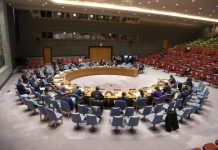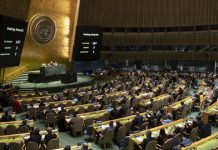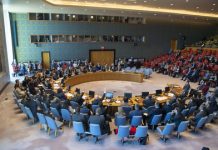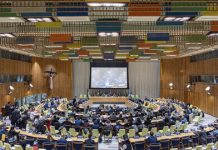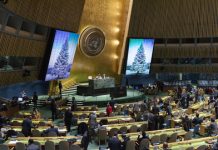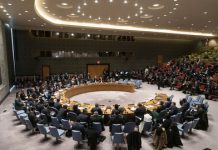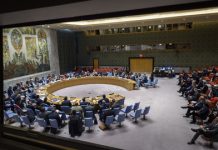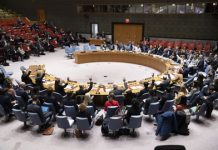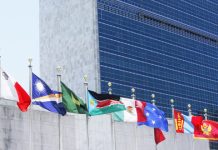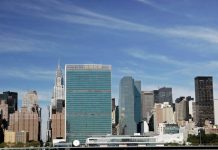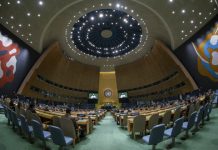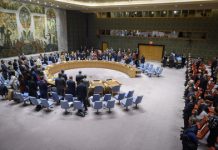UN News: Hamish Young, UNICEF Senior Emergency Coordinator for Gaza, thank you for joining us today. First, would you please tell us more about the launch of the second phase of polio vaccination in Gaza: where it started today and its goal, and how did the first day go?
Hamish Young: We started today in Deir Al-Balah. I visited five different sites personally, and one of them was at the International Medical Corps (IMC) hospital. And it’s important to recognize this is a multiagency effort. Like everything in Gaza, we’re all very dependent on UNRWA. They provide the backbone, they provide the infrastructure, the majority of the primary healthcare workers. And then, of course, as is the standard, the norm, under the Global Polio Eradication Initiative partnership, WHO provide the technical leadership on the vaccination, UNICEF provide the communication side of it, the community mobilization, and the cold chain and the vaccines. And here we also rely on a lot of the NGOs. So, it’s important to recognize it’s a big combined interagency effort.
So, at the IMC hospital, you know, I met, of course, the Ministry of Health are playing an important role too, and then we went and visited number of the vaccination sites spread around Deir Al-Balah.
Normally, in a polio campaign, you would, you try to do everywhere, all at once. That’s not possible under the current conflict setting in Gaza. So the Israel Defense Forces (IDF) have given us three phases. So, we do one in the middle of Gaza, one in the south, and then from the 22 and 23 October, we’ll be doing the northern part, which is going to be the most challenging. We’re aiming to vaccinate 540,000 children up to 10 years of age. That was felt by the Ministry of Health to be appropriate, because it’s 10 years since the type of vaccine that we need to use here was last used, so it’s catching everyone. And we’re also adding Vitamin A this time around for two- to 10-year-olds.
I just left the operation centre where the teams are tallying the numbers, so I don’t have the final numbers. But just from my observations at five or six sites, it all seemed to be going well.
One thing that was interesting: in my past experience with polio campaigns, the more you do it, the harder it becomes to mobilize the community because people, mothers, think, “Oh, my kids already had a dose. It’s okay. I’m fine.” But here we found a different dynamic, and actually a positive dynamic. We were told by a number of the different vaccination teams that more parents and caregivers were bringing their kids in than had been before because they’d seen the first round and maybe had heard some rumours – you know, there’s many false rumours about all sorts of vaccines, including polio. But then they’d observed, for example, their neighbours had their kids vaccinated. The kid was fine, no side effects, nothing like that. And they’re like, “Okay, so it’s fine.” So, we got what looked like a more, slightly more, positive turnout on that basis, which is, to be honest, not what I expected, but very positive and very welcome.
UN News: You’ve mentioned some of the challenges, but let’s talk more about those challenges. Do you think it’s different this time, the vaccination campaign, or the second phase of that campaign, given the new evacuation orders and ongoing escalation in several parts of Gaza, especially in the north?
Hamish Young: Well, where we’re operating at the moment in the Middle Area, and then next week, it’ll be in the Southern Area. It’s more or less the same as last time. But you’re absolutely right. There’s a new type of evacuation order in the north, and the IDF has declared almost all of the two northern governorates to be combat zones, and then they’ve created this new definition of evacuation order. They call them polygons. It’s just a different classification of areas. Yes, so that could be more challenging.
However, our position is that the IDF and the Government of Israel have committed themselves to supporting two rounds of polio campaign, and they’ve committed themselves to ensuring that we reach all children who are in need. Therefore, we expect that by the time we come to the north, we get the same access that we got last time. So, we get free access to the same areas that we were able to reach last time, and we get coordinated access outside those areas where need be.
So, at the moment, as you say, yes, there’s a lot of conflict going on. Jabalya and Jabalya camp are under evacuation orders, and there’s a lot of conflict going on around there. But we expect, and we really call on the Government of Israel and the IDF to adhere to the commitments that they’ve already made to give the polio campaign access to all children in there. That’s in accordance with the rights of those children, and it’s also in accordance with international humanitarian law: that we should be able to have free and unfettered access, and that all the polio teams should be fully protected from the effects of the conflict.
UN News: What is needed the most right now to make this round successful?
Hamish Young: Access. We need facilitation, and we need access by all the parties to the conflict, but it’s the IDF that controls that access. We have all the supplies we need. We have all the logistical infrastructure – the cold chain, the refrigerators, the refrigerator trucks, the cold boxes, finger markers, communications material – everything that you need to go along with a polio programme. We’ve got the human resources; we’ve got the teams. We’ve done the training; they’ve done it before. From our side, there’s no constraints to prevent us from reaching all children who are in need. What will constrain us, or the only thing that can stop us is lack of access.
UN News: You mentioned that as part of the campaign, children will receive Vitamin A in addition to the novel oral polio type-2 vaccine. Why is that important?
Hamish Young: Well, it’s important because Vitamin A boosts their immunity and protects them against a number of diseases, but it also helps the absorption and the uptake of the polio vaccine. And that’s important where you’re dealing with a population of kids who are suffering from nutritional problems, gastroenteritis, intestinal problems. Those are the sorts of things that reduce the efficacy of the polio vaccine, the oral polio vaccine. And as you know, it’s oral vaccine that is needed to eradicate polio.
UN News: Many children in Gaza are facing malnutrition. Could you tell us more about the situation right now in Gaza?
Hamish Young: The situation with the nutritional status of the children is interesting because, well firstly, there’s never been malnutrition in Gaza before this conflict. So, the primary health care workers, even the more senior medical staff, are not really versed in recognizing malnutrition and then in treating it. So, we’ve done a lot of capacity building and training to try and boost that ability.
Then we’ve been through – how to describe it – sort of waves, where, from November, when I first arrived here, December, January, February, into March, we saw increasing rates of malnutrition, particularly in the two northern governorates. As you probably know, the IDF divided Gaza in two. The two northern governorates are separated from the south by a military corridor which has two military checkpoints. And access to the north is very, very tightly regulated and controlled, and it’s very difficult to take supplies up there.
And then we had the IPC report come out that said significant numbers of children were very malnourished, and in fact, we were headed towards a declaration of famine. And then there was an easing of restrictions at that point. The southern parts of Gaza were opened up to commercial supplies from commercial trucks, which are very important part of the equation because the humanitarian agencies on their own can’t and shouldn’t be the only ones to provide the relief. And then there was an entrance opened in the north that allowed food to come in there.
The problem going forward is that there isn’t enough variety of food. So, you know, between the canned food and the flour for bread, we reached a point where there were probably enough kilocalories just, but not enough micronutrients. And now we are seeing that situation backslide because the IDF never allowed the commercial trucks into the north. It’s the commercial trucks that bring the fresh fruit and vegetables. So, we’ve seen a deterioration of nutritional status in the north, and now we’re going to start seeing it in the south because the IDF have announced that no more commercial trucks can come into the south. So, we’re going to see the same problem occurring there.
Source of original article: United Nations (news.un.org). Photo credit: UN. The content of this article does not necessarily reflect the views or opinion of Global Diaspora News (www.globaldiasporanews.com).
To submit your press release: (https://www.globaldiasporanews.com/pr).
To advertise on Global Diaspora News: (www.globaldiasporanews.com/ads).
Sign up to Global Diaspora News newsletter (https://www.globaldiasporanews.com/newsletter/) to start receiving updates and opportunities directly in your email inbox for free.



